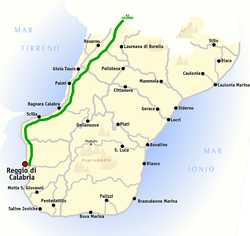San Luca
San Luca, Calabria, Italy | |
|---|---|
| Comune di San Luca | |
 View of San Luca | |
 Map of the province of Reggio Calabria | |
| Coordinates: 38°9′N 16°4′E / 38.150°N 16.067°E | |
| Country | Italy |
| Region | Calabria |
| Metropolitan city | Reggio Calabria (RC) |
| Frazioni | Ientile, Polsi, Ricciolio, Stranges, Vorea |
| Government | |
| • Mayor | Prefectural Commissioner |
| Area | |
| • Total | 104.2 km2 (40.2 sq mi) |
| Elevation | 250 m (820 ft) |
| Population (Dec. 2007)[2] | |
| • Total | 4,126 |
| • Density | 40/km2 (100/sq mi) |
| Demonym | Sanluchesi |
| Time zone | UTC+1 (CET) |
| • Summer (DST) | UTC+2 (CEST) |
| Postal code | 89030 |
| Dialing code | 0964 |
| Patron saint | St. Luke the Evangelist |
| Saint day | October 18 |
San Luca is a comune (municipality) in the Province of Reggio Calabria in the Italian region Calabria, located about 100 kilometres (62 mi) southwest of Catanzaro and about 35 kilometres (22 mi) east of Reggio Calabria. The town is situated on the eastern slopes of the Aspromonte mountain, in the valley of the Bonamico river. At about 10 kilometres (6 mi) from San Luca up the mountain lies the Sanctuary of Our Lady of Polsi.
The Italian author Corrado Alvaro was born in San Luca in 1895. His hand-written notes and other personal belongings are now kept in the house where he was born by the Corrado Alvaro Foundation.[3]
History
San Luca was founded on October 18, 1592, by the Prince Sigismund Loffredo and named after the saint of that particular day, Luke the Evangelist, who became the patron saint of the town. It was populated by refugees from the old town of Potamia, which was destroyed by landslides.[4] San Luca became a comune in 1811, and was hit by floods and landslides in 1951, 1953 and December 1972.[5]
Around 1900, at the time the young Corrado Alvaro grew up in San Luca, illiteracy was near 100 percent and the town had no drinking water. The women went to fetch water with the casks on their heads at a well nearby. The town was pretty much isolated; there was no road to the coast and the only way to get there was on foot. Many inhabitants joined the Italian diaspora to escape the extreme poverty.[6]
Stronghold of the 'Ndrangheta
San Luca is considered to be the stronghold of the 'Ndrangheta, a Mafia-type criminal organisation based in Calabria. According to a former 'ndranghetista, "almost all the male inhabitants belong to the 'Ndrangheta, and the Sanctuary of Our Lady of Polsi has long been the meeting place of the affiliates, known as the Crimine."[7] At least since the 1950s, the chiefs of the 'Ndrangheta locali have met regularly near the Sanctuary of Our Lady of Polsi during the September Feast. In 1969 the police raided a meeting near the sanctuary and captured more than 70 'ndranghetisti, while others managed to escape.[8]
The historical preeminence of the San Luca family is such that every new group or locale must obtain its authorization to operate and every group belonging to the 'Ndrangheta "still has to deposit a small percentage of illicit proceeds to the principale of San Luca in recognition of the latter’s primordial supremacy."[9] San Luca, in the words of a study published in 2005 by Italy's domestic intelligence service, is "the cradle of [the 'Ndrangheta] and its epicentre".[10]
The San Luca feud, a war between the two 'Ndrangheta clans Pelle-Vottari-Romeo and Strangio-Nirta from San Luca that had started in 1991 and resulted in several deaths carried into Germany in 2007; six men were shot to death in front of an Italian restaurant in Duisburg on 15 August 2007.[11][12]
Demographic evolution

Notable people
- Corrado Alvaro (1895–1956), journalist and writer
- Antonio Pelle (1932–2009), also known as Ntoni Gambazza, a historically significant 'Ndrangheta boss
- Antonio Nirta (1919–2015), a historically significant 'Ndrangheta boss
References
- ^ "Superficie di Comuni Province e Regioni italiane al 9 ottobre 2011". Italian National Institute of Statistics. Retrieved 16 March 2019.
- ^ All demographics and other statistics: Italian statistical institute Istat.
- ^ San Luca: the story and traditions Archived 2011-07-26 at the Wayback Machine, Movimento Donne San Luca e della Locride
- ^ Template:It icon Storia Archived 2010-09-19 at the Wayback Machine, Fondazione Corrado Alvaro
- ^ Template:It icon San Luca
- ^ Template:It icon Il paese di Alvaro, Fondazione Corrado Alvaro
- ^ Paoli. Mafia Brotherhoods, p. 29
- ^ Paoli. Mafia Brotherhoods, p. 59
- ^ Paoli. Mafia Brotherhoods, p. 29-30
- ^ Silence on the streets of Calabria's mafia capital as deadly feud crosses borders, The Guardian, August 17, 2007
- ^ How the tentacles of the Calabrian Mafia spread from Italy, Times Online, 15 August 2007
- ^ Six Italians Killed in Duisburg, Spiegel Online, 15 August 2007
- Paoli, Letizia (2003). Mafia Brotherhoods: Organized Crime, Italian Style. New York: Oxford University Press. ISBN 0-19-515724-9.
External links
- All In The Famiglia: Cracking omertà in Calabria, by Bruce Livesey, The Walrus Magazine, May 2008





